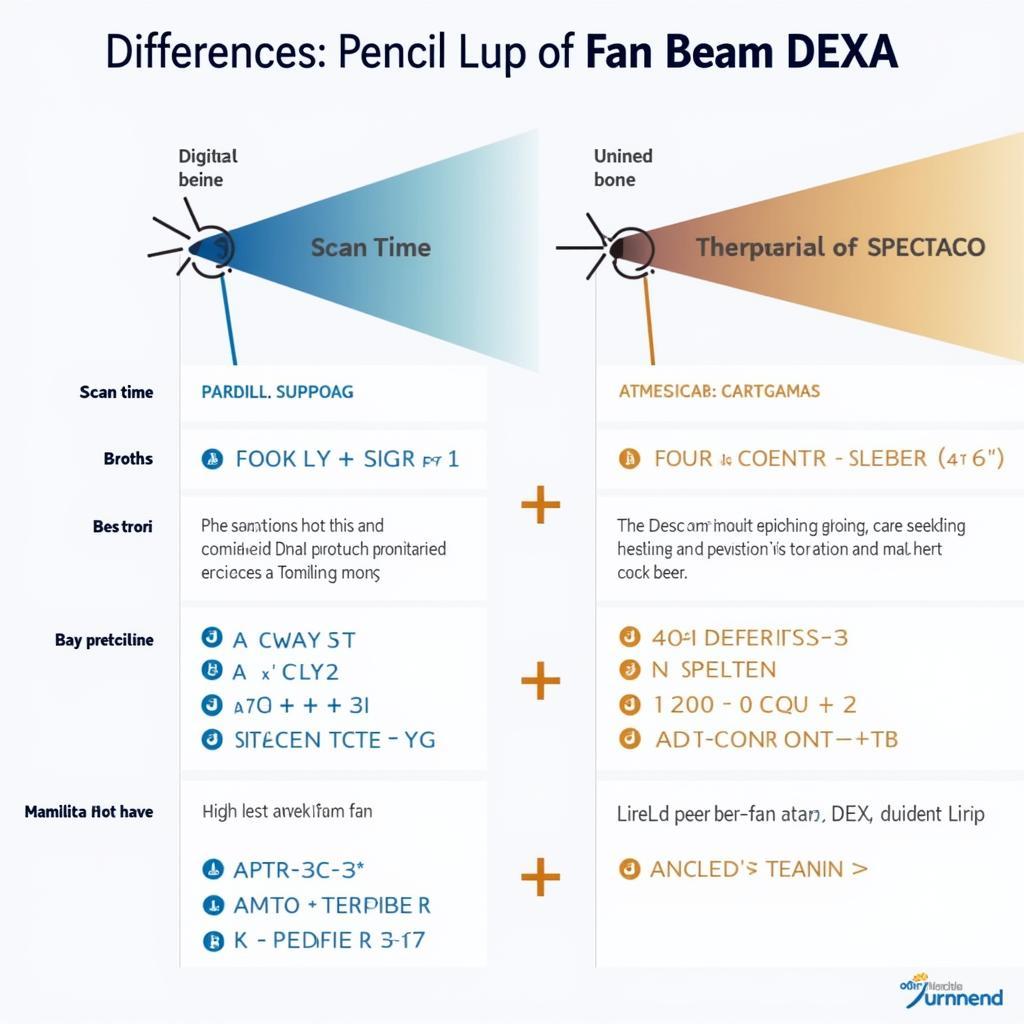DEXA (Dual-energy X-ray absorptiometry) scans are a common tool for measuring bone density and body composition. Understanding the difference between pencil beam and fan beam, two distinct technologies used in DEXA scanners, is crucial for both healthcare professionals and patients. This article delves into the nuances of each, exploring their mechanisms, advantages, and limitations.
How Pencil Beam DEXA Works
Pencil beam DEXA scanners utilize a very narrow, highly collimated X-ray beam, resembling a pencil, to scan the body. This narrow beam scans across the patient in a rectilinear fashion, building up a composite image row by row. This process, while precise, can be time-consuming. The pencil beam provides very accurate measurements, reducing the influence of surrounding tissues on bone density readings.
How Fan Beam DEXA Works
Fan beam DEXA, in contrast, employs a fan-shaped X-ray beam. This broader beam allows for faster scanning times compared to pencil beam, covering a larger area with each pass. The fan beam DEXA system uses a detector array to measure the X-ray attenuation, processing the data to create an image of the scanned area. While faster, fan beam systems can be slightly less precise than pencil beam systems due to greater scatter radiation.
Comparing Pencil Beam and Fan Beam DEXA
The key difference between pencil beam and fan beam DEXA lies in the shape of the X-ray beam and its implications for scan time and precision. Pencil beam offers superior precision due to its narrow, focused beam, minimizing scatter radiation. However, this precision comes at the cost of longer scan times. Fan beam, with its wider beam, enables faster scans, making it more practical for high-volume settings. However, the increased scatter radiation can slightly compromise precision.
Scan Time Differences
The scan time difference is a significant factor to consider. Pencil beam scans can take several minutes, while fan beam scans are typically completed in seconds. This makes fan beam DEXA more suitable for patients who may find it difficult to remain still for extended periods.
Precision and Accuracy
While both technologies offer accurate measurements, pencil beam DEXA is generally considered to be more precise. The narrow beam minimizes the impact of surrounding soft tissues on bone density readings.
Advantages and Disadvantages of Each Method
Pencil Beam Advantages:
- Higher precision
- Reduced scatter radiation
Pencil Beam Disadvantages:
- Longer scan times
Fan Beam Advantages:
- Faster scan times
- More practical for high-volume settings
Fan Beam Disadvantages:
- Slightly less precise than pencil beam
- More susceptible to scatter radiation
“The choice between pencil beam and fan beam DEXA depends on the specific clinical need,” states Dr. Emily Carter, a renowned radiologist specializing in bone densitometry. “For research purposes where high precision is paramount, pencil beam is often preferred. However, for routine clinical practice, the speed and efficiency of fan beam are highly beneficial.”
Which DEXA Scan is Right for You?
Ultimately, the choice between pencil beam and fan beam DEXA depends on individual circumstances and the specific requirements of the examination. Consulting with a healthcare professional will help determine the most appropriate method based on your individual needs and the clinical context.
 Comparison Chart Pencil vs Fan Beam DEXA
Comparison Chart Pencil vs Fan Beam DEXA
Conclusion
Understanding the Difference Between Pencil Beam And Fan Beam In Dexa is essential for informed decision-making. While pencil beam offers superior precision, fan beam provides faster scan times. By weighing the advantages and disadvantages of each method, healthcare professionals can select the optimal technology to meet the unique needs of each patient. By understanding these differences, patients can also engage in more informed discussions with their doctors.
FAQs
- What is DEXA used for? DEXA is primarily used to measure bone density and assess the risk of osteoporosis. It can also be used to measure body composition.
- Is DEXA safe? DEXA scans use very low levels of radiation and are considered safe.
- How long does a DEXA scan take? Fan beam scans take a few seconds, while pencil beam scans can take several minutes.
- How often should I have a DEXA scan? The frequency of DEXA scans depends on individual risk factors and should be determined by a healthcare professional.
- Do I need to prepare for a DEXA scan? Generally, no special preparation is required for a DEXA scan.
- What is scatter radiation? Scatter radiation is radiation that has been deflected from its original path, potentially affecting the accuracy of the scan.
- What is bone densitometry? Bone densitometry is the measurement of bone mineral density, used to assess bone health.
“For most patients, the speed and convenience of fan beam are sufficient,” adds Dr. David Miller, a leading expert in osteoporosis. “However, specific research protocols or clinical scenarios may benefit from the increased precision offered by pencil beam technology.”
Need support? Contact us 24/7: Phone: 0903426737, Email: [email protected] or visit us at Lot 9, Area 6, Gieng Day Ward, Ha Long City, Quang Ninh, Vietnam.


